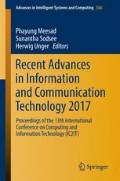Abstract
In disaster environment such as Tsunami, people need to evacuate to safety shelter immediately. Using vehicle is the fastest way to evacuate. In case of emergency, instead of a specific destination, one needs to find route to a safety shelter, any one which could be accessed in shortest time. Existing navigation systems too can search a service instead of a specific destination. It calculates routes to nearby service points, and present a list of results to the user. The user has to take decision to select one from the list. In general people in the same area will get the same result from the system, and choose the shortest route, i.e., the nearest service point. In densely populated area, traffic congestion will appear in shortest route in a short time. Moreover destination accessible by the shortest route will quickly run out of service. It is better to choose different routes or different destinations from the beginning, by which traffic congestion could be avoided, and users will be distributed over several service points. In this paper, we proposed routing algorithm and navigation system to recommend optimum routes and destinations to users in a disaster environment. This navigation system can calculate and recommend routes considering multiple destinations and limited available resources at destinations, simultaneously.
Access this chapter
Tax calculation will be finalised at checkout
Purchases are for personal use only
References
Anderson, R.: Electromagnetic loop vehicle detectors. IEEE Trans. Veh. Technol. 19(1), 23–30 (1970)
Bellman, R.: On a routing problem. Q. Appl. Math. 16, 87–90 (1958)
Chiu, Y.C., Transportation Research Board, Transportation Network Modeling Committee, National Research Council (U.S.): Dynamic Traffic Assignment: A Primer. Transportation Research Circular. Transportation Research Board (2011). https://books.google.co.th/books?id=J7aEnQAACAAJ
Cho, H.J., Lan, C.L.: Hybrid shortest path algorithm for vehicle navigation. J. Supercomput. 49(2), 234–247 (2009). http://dx.doi.org/10.1007/s11227-008-0236-7
Delling, D., Sanders, P., Schultes, D., Wagner, D.: Engineering route planning algorithms. In: Lerner, J., Wagner, D., Zweig, K.A. (eds.) Algorithmics of Large and Complex Networks: Design, Analysis, and Simulation, pp. 117–139. Springer, Heidelberg (2009). http://dx.doi.org/10.1007/978-3-642-02094-0_7
Dijkstra, E.W.: A note on two problems in connexion with graphs. Numer. Math. 1(1), 269–271 (1959)
Google: Google maps. http://www.google.com/maps/
Haklay, M., Weber, P.: Openstreetmap: user-generated street maps. IEEE Pervasive Comput. 7(4), 12–18 (2008)
Krajzewicz, D., Erdmann, J., Behrisch, M., Bieker, L.: Recent development and applications of SUMO - Simulation of Urban MObility. Int. J. Adv. Syst. Meas. 5(3–4), 128–138 (2012). http://elib.dlr.de/80483/
Lee, J., Hatoyama, K., Ieda, H.: Formulation of tsunami evacuation strategy to designate routes for the car mode - lessons from the three cities in Tohoku area, Japan. Proc. East. Asia Soc. Transp. Stud. 9, 12 (2013). http://www.easts.info/on-line/proceedings/vol9/PDF/P41.pdf
OpenStreetMap: Openstreetmap. http://www.openstreetmap.org/
Peeta, S., Ziliaskopoulos, A.K.: Foundations of dynamic traffic assignment: the past, the present and the future. Netw. Spat. Econ. 1, 233–265 (2001)
Sub-r-pa, C., Chakraborty, G., Sinha, B.P.: Route recommendation system to support multiple destinations and multiple routes to minimize road congestion. Int. J. Commun. Netw. Distrib. Syst. 17 (in press)
Uzcategui, R., Acosta-Marum, G.: Wave: a tutorial. IEEE Commun. Mag. 47(5), 126–133 (2009)
Yen, J.Y.: Finding the k shortest loopless paths in a network. Manage. Sci. 17(11), 712–716 (1971)
Author information
Authors and Affiliations
Corresponding author
Editor information
Editors and Affiliations
Rights and permissions
Copyright information
© 2018 Springer International Publishing AG
About this paper
Cite this paper
Sub-r-pa, C., Chakraborty, G., Sinha, B.P. (2018). Optimum Route Recommendation System to Escape Disaster Environment. In: Meesad, P., Sodsee, S., Unger, H. (eds) Recent Advances in Information and Communication Technology 2017. IC2IT 2017. Advances in Intelligent Systems and Computing, vol 566. Springer, Cham. https://doi.org/10.1007/978-3-319-60663-7_25
Download citation
DOI: https://doi.org/10.1007/978-3-319-60663-7_25
Published:
Publisher Name: Springer, Cham
Print ISBN: 978-3-319-60662-0
Online ISBN: 978-3-319-60663-7
eBook Packages: EngineeringEngineering (R0)

